Beacon Hill & West End
Otis House Museum, 141 Cambridge Street
Harrison Gray Otis made a fortune as co-developer of Beacon Hill and was the third mayor of Boston. He needed a house that reflected his wealth and status, so he asked his friend Charles Bullfinch(architect of Massachusetts State House) to design it. This West End mansion was finished in 1796, the first of three designed for Otis by Bullfinch. After the Otis family moved on the house went into decline, eventually becoming a boarding house. It was bought by the Society for the Preservation of New England Antiquities in 1916 and they restored it internally and externally to the period around 1800. It is open for tours.
DLU090807
Click on Minimap to navigate
Home > US States > New England > Massachusetts > Boston >
By the late 18th century, the North End and Old Boston had become overcrowded, so the city began to spread westwards to the West End which is the area bounded by the Charles River and Cambridge Street. To the south of the West End is Beacon Hill, the highest point near the centre of Boston and hence once the site of a beacon. Development spread up the south facing slope of Beacon Hill, and by the 19th century it was where Boston’s wealthy people lived. In contrast, the West End including the north slope of Beacon Hill was settled mainly by free blacks, sailors and tradesmen. Beacon Hill went into decline towards the end of the 19th century when the Back Bay area became more fashionable for the wealthy. An urban renewal project in the late 1950s revived Beacon Hill and it is once again and expensive and fashionable area.
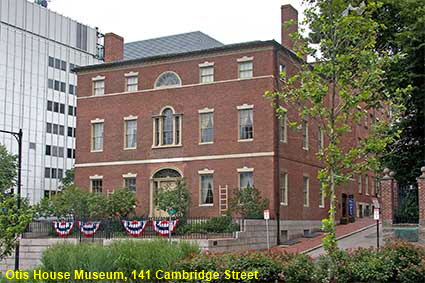
Louisburg Square
Probably the best example of the exclusivity of Beacon Hill is Louisburg Square. This private preserve was developed in the 1830s. Round the square are bow fronted Greek Revival houses while in the middle is a small garden surrounded by a high iron fence. The square was named after the 1745 Battle of Louisbourg (note the difference in spelling), in which Massachusetts militiamen led by William Pepperrell sacked the French Fortress of Louisbourg in modern day Nova Scotia. Louisa May Alcott, author of ‘Little Women’, lived on the square in the 19th century. A Louisburg Square address remains highly prestigious and the houses are among the most expensive in the USA.
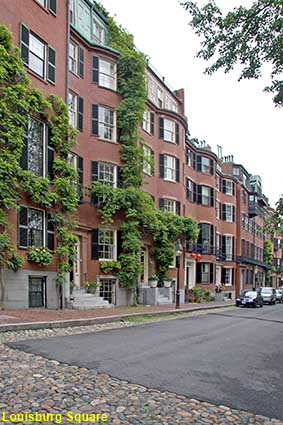
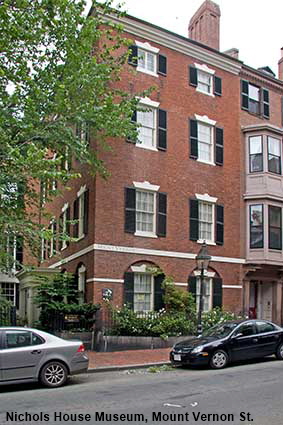
Nichols House Museum, Mount Vernon Street
Charles Bullfinch designed many houses on the posh southern slope of Beacon Hill. The Nichols House Museum is an 1804 four storey town house that was originally designed by Bullfinch. It was modernised in 1830 with the addition of a Greek-revival portico. Thirteen year old Rose Standish Nichols moved into the house in 1883 when her father purchased it, and she lived there until her death in 1960. Rose did not marry, but dedicated her life to pacifism and women’s rights. She was also an author and landscape gardener. In her will she left the house to be made into a museum. It is open for tours and gives an insight into the domestic life of a typical family of Beacon Hill at the end of the 19th century.
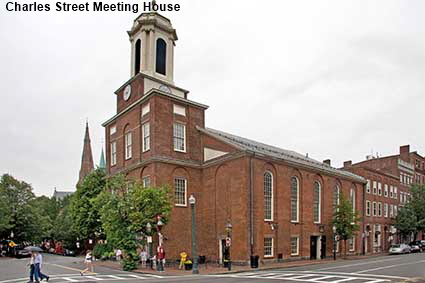
Charles Street Meeting House
Charles Street once ran along the bank of the Charles River, but due to landfill it is now well inland. In 1807 the Charles Street Meeting House was built on the river bank for the Third Baptist Church to a design by Asher Benjamin. In 1876 due to dwindling congregations, the Baptists sold it to the First African Methodist Episcopal Church who used it until 1939. It is no longer a church, but is now used for commercial purposes.
African Meeting House & Abiel Smith School
While the south slope of Beacon Hill reflects the history of Boston’s wealthiest residents, the north slope is more diverse. Between 1800 and 1900, most of the African Americans who lived in the city lived in this area. The African Meeting House (centre of the picture) was built in 1806 and was the home of the First African Baptist Congregation through to the 1890s. In 1808 an African School was established in the basement. Abiel Smith, a white businessman, left $2,000 to the city of Boston for the education of black children. His bequest was used to build a larger African School, which operated from 1834 to 1855. The School is to the left of the Meeting House in the picture. Both buildings have been preserved and are on the Black Heritage Trail, a walking tour that explores how Boston's African American community lived in the 19th century.
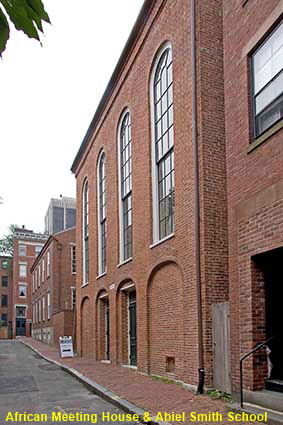


To move forwards or backwards through the Boston trail click the arrows above, or select your next destination on the Minimap.
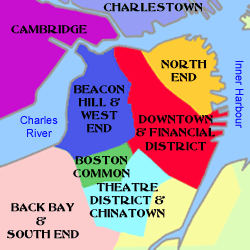

© Mike Elsden 1981 - 2025
The contents of this page may not be reproduced in full or in part without permission